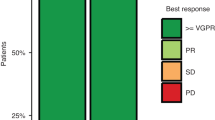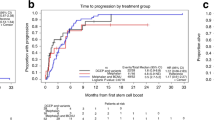Abstract
Still, many physicians give 4 cycles of combination therapy to multiple myeloma patients prior to collection of stem cells for autologous bone marrow transplant. This tradition originates from older doxorubicin-containing regiments which limited the number of cycles due to cumulative cardiotoxicity. Using older regiments, most patients had residual myeloma cells in their autologous stem-cell grafts during collection. Emerging data show that newly diagnosed multiple myeloma patients treated with modern carfilzomib/lenalidomide/dexamethasone (KRd) therapy, on average, take 6 cycles until reaching minimal residual disease (MRD) negativity. We assessed newly diagnosed patients treated with KRd focusing MRD status both in the individual patient’s bone marrow, and the corresponding autologous hematopoietic progenitor cell grafts during collection. Per protocol, stem-cell collection was allowed after 4 to 8 cycles of KRd. We found similar stem-cell yield independent of the number of cycles of KRd. At stem-cell collection, 11/30 patients (36.6%) were MRD negative in their bone marrow; all 11 patients had MRD negative hematopoietic progenitor cell grafts. Furthermore, 18/19 patients who were MRD positive in their bone marrows also had MRD negative hematopoietic progenitor cell grafts. These observations support 6 cycles of KRd as an efficacious and safe induction strategy prior to stem-cell collection.
This is a preview of subscription content, access via your institution
Access options
Subscribe to this journal
Receive 12 print issues and online access
$259.00 per year
only $21.58 per issue
Buy this article
- Purchase on Springer Link
- Instant access to full article PDF
Prices may be subject to local taxes which are calculated during checkout

Similar content being viewed by others
References
Kay NE, Leong T, Kyle RA, Greipp P, Billadeau D, Van Ness B, et al. Circulating blood B cells in multiple myeloma: analysis and relationship to circulating clonal cells and clinical parameters in a cohort of patients entered on the Eastern Cooperative Oncology Group phase III E9486 clinical trial. Blood. 1997;90:340–5.
Zandecki M, Bernardi F, Genevieve F, Laï JL, Preudhomme C, Flactif M, et al. Involvement of peripheral blood cells in multiple myeloma: chromosome changes are the rule within circulating plasma cells but not within B lymphocytes. Leukemia. 1997;11:1034–9.
Stewart AK, Vescio R, Schiller G, Ballester O, Noga S, Rugo H, et al. Purging of autologous peripheral-blood stem cells using CD34 selection does not improve overall or progression-free survival after high-dose chemotherapy for multiple myeloma: results of a multicenter randomized controlled trial. J Clin Oncol. 2001;19:3771–9.
Bourhis JH, Bouko Y, Koscielny S, Bakkus M, Greinix H, Derigs G, et al. Relapse risk after autologous transplantation in patients with newly diagnosed myeloma is not related with infused tumor cell load and the outcome is not improved by CD34+ cell selection: long term follow-up of an EBMT phase III randomized study. Haematologica. 2007;92:1083–90.
Korde N, Roschewski M, Zingone A, Kwok M, Manasanch EE, Bhutani M, et al. Treatment with carfilzomib-lenalidomide-dexamethasone with lenalidomide extension in patients with smoldering or newly diagnosed multiple myeloma. JAMA Oncol. 2015;1:746–54.
Vasu S, Leitman SF, Tisdale JF, Hsieh MM, Childs RW, Barrett AJ, et al. Donor demographic and laboratory predictors of allogeneic peripheral blood stem cell mobilization in an ethnically diverse population. Blood. 2008;112:2092–100.
Tembhare PR, Yuan CM, Venzon D, Braylan R, Korde N, Manasanch E, et al. Flow cytometric differentiation of abnormal and normal plasma cells in the bone marrow in patients with multiple myeloma and its precursor diseases. Leuk Res. 2014;38:371–6.
Paiva B, Cedena MT, Puig N, Arana P, Vidriales MB, Cordon L, et al. Minimal residual disease monitoring and immune profiling in multiple myeloma in elderly patients. Blood. 2016;127:3165–74.
Kumar S, Paiva B, Anderson KC, Durie B, Landgren O, Moreau P, et al. International Myeloma Working Group consensus criteria for response and minimal residual disease assessment in multiple myeloma. Lancet Oncol. 2016;17:e328–46.
Kumar S, Dispenzieri A, Lacy MQ, Hayman SR, Buadi FK, Gastineau DA, et al. Impact of lenalidomide therapy on stem cell mobilization and engraftment post-peripheral blood stem cell transplantation in patients with newly diagnosed myeloma. Leukemia. 2007;21:2035–42.
Landgren O, Giralt S. MRD-driven treatment paradigm for newly diagnosed transplant eligible multiple myeloma patients. Bone Marrow Transplant. 2016;51:913–4.
Acknowledgements
We thank all of the patients who contributed to this study, as well as the clinical and research staff at the Intramural Program at the National Cancer Institute, National Institutes of Health. Carfilzomib and lenalidomide, as well as funding for parts of the correlative assays for the study, were provided by Amgen and Celgene to the National Cancer Institute of the National Institutes of Health as part of a cooperative research and development agreement. The study was supported by the Intramural Program at the National Cancer Institute, National Institutes of Health; and Memorial Sloan Kettering Core Grant, Core Grant (P30 CA008748) for grant support of this work.
Funding
Amgen and Celgene had no role in the design and conduct of the study; the collection, management, analysis, and interpretation of the data; approval of the manuscript; and decision to submit the manuscript for publication.
Author information
Authors and Affiliations
Corresponding author
Ethics declarations
Conflict of interest
Dr. Landgren has given scientific talks at meetings supported by unrestricted grants from Amgen, Celgene, Takeda, BMS, Janssen, and Merck; he has served on Independent Data Monitoring Committees (IDMCs) for clinical trials led by Janssen, Takeda, and Merck; also he has served as the Chairman for Medscape Myeloma Program. The authors declare that they have no conflict of interest.
Rights and permissions
About this article
Cite this article
Tageja, N., Korde, N., Kazandjian, D. et al. Combination therapy with carfilzomib, lenalidomide and dexamethasone (KRd) results in an unprecedented purity of the stem cell graft in newly diagnosed patients with myeloma. Bone Marrow Transplant 53, 1445–1449 (2018). https://doi.org/10.1038/s41409-018-0170-0
Received:
Revised:
Accepted:
Published:
Issue Date:
DOI: https://doi.org/10.1038/s41409-018-0170-0
This article is cited by
-
Clinical value of measurable residual disease testing for multiple myeloma and implementation in Japan
International Journal of Hematology (2020)
-
Carfilzomib with immunomodulatory drugs for the treatment of newly diagnosed multiple myeloma
Leukemia (2019)



